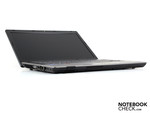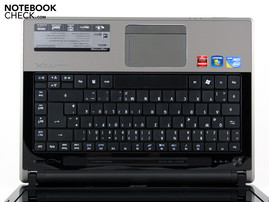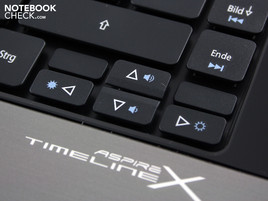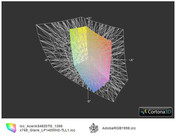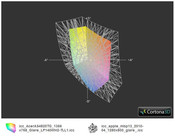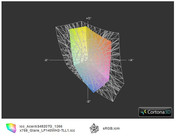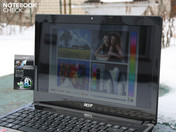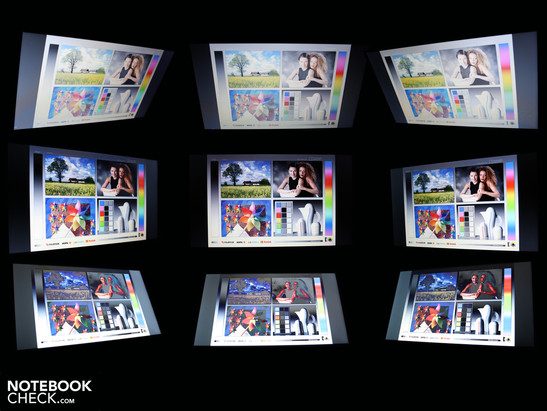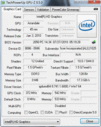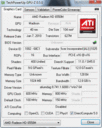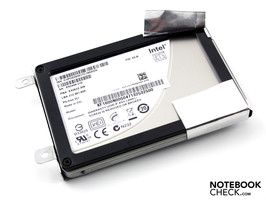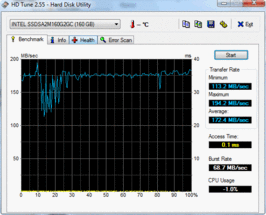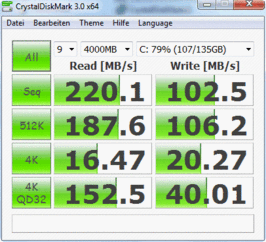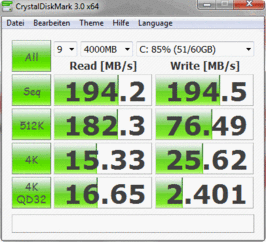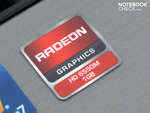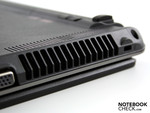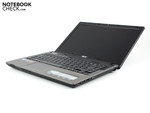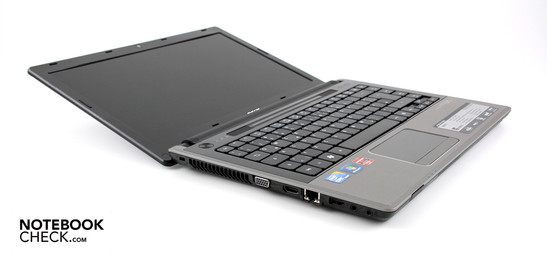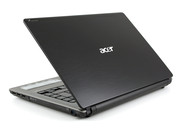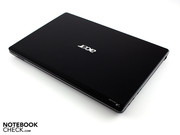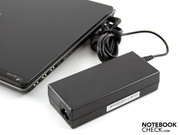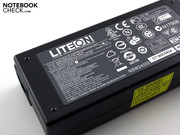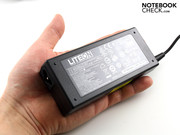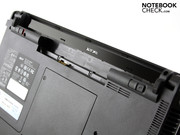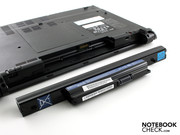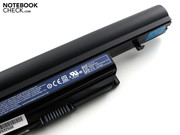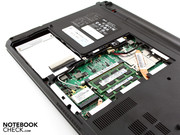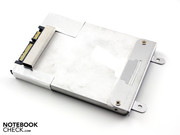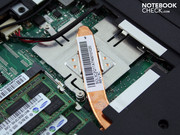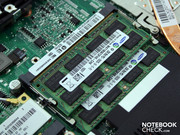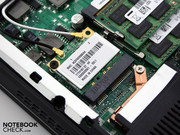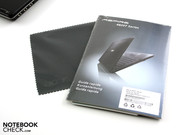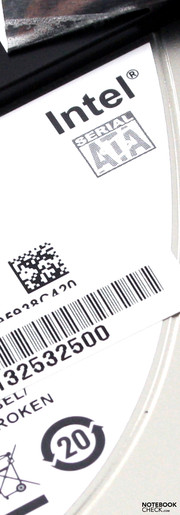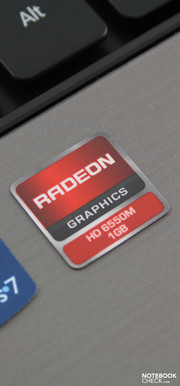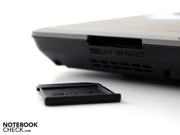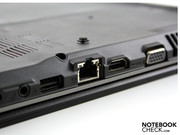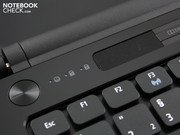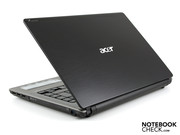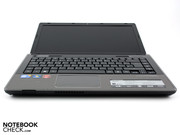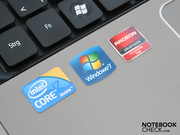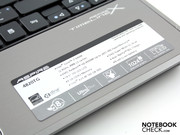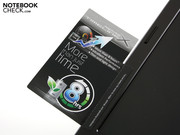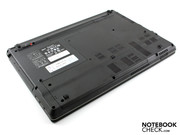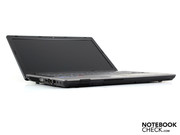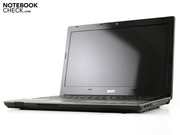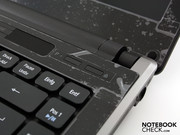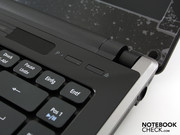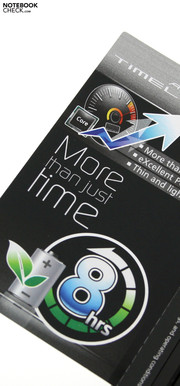Review Acer Aspire 4820TG (i7/HD 6550) Notebook

As Intel's Sandy Bridge processors (32nm) have just been officially announced (Review Intel Intel Sandy Bridge quad core processors), we discover strong Arrandale-CPUs (32nm) like the Core i7-640M on the market.
The dual core (2x 2.80 GHz) is favored for expensive business subnotebooks (Sony Vaio VPC-Z13Z9E/X; Toshiba Portégé R700-172; Lenovo ThinkPad T510 Optimus; HP Elitebook 8540w; Fujitsu Lifebook S760; Fujitsu Celsius H700; Dell Latitude E6410). Now consumers also have an option of buying the i7-640M together with an Intel SSD (160 GB) and a faster graphics card (AMD Radeon HD 6550) at an acceptable price.
A handy 14 inch device could be created at a price of 1299 euros, which supplies a very strong application performance (SSD + i7) and a good gaming performance (HD 6550). Can the HD 5650 successor assert itself against the current Nvidia competition? How much battery life does the TimelineX 4820TG have in view of the 35 watt CPU and potent graphics card? How will the 14 incher deal with waste heat and system noise? We will answer all questions in this detailed review.
Case
We will dedicate the shortest part of this review to workmanship and looks. Nothing has changed in comparison to the first review (May 2010: 4820TG-434G64Mn). The display prone for scratching has been maintained, just like the base unit that can be depressed evidently over the DVD drive. After the drawbacks, there are advantages, though. For example, the high-end aluminum haptics and the tightly mounted hinges. Detailed information in our first 4820TG review.
Connectivity
We also refer to our first 4820TG review in terms of interfaces. Neither USB 3.0 nor any other port has been added. Even the Ethernet and the WLAN module are of the same kind (Atheros AR8151/AR5B97). A tiny update is found in the Bluetooth. Now the latest 3.0 +HS standard is at the start.
Input Devices
We refer to our first 4820TG review one last time. We prefer the touchpad, with its quiet keys and large surface, to the keyboard. The latter coils over the optical drive (right) and the pressure point isn't clearly defined. Nevertheless, it's basically possible to type acceptably.
Display
At last there is something new to report about. The LG-Phillips screen (LP140WH2-TLL1) has (regrettably) worsened. The previously installed AUO screen (AUO303C) was brighter by an average of 57 cd/m2. More about that in brightness.
The 16:9 display's resolution of 1366x768 pixels is standard for the 14.1 inch size. The poor contrast of 128:1 doesn't at all fit to a multimedia laptop. Games, pictures and movies aren't as brilliant and drift off into a blurred spectrum. The glare type (not AR coated) restores a certain amount of brilliance optically, but it can't compensate the poor black value of 1.42 cd/m2.
In regards to the color spectrum, it also becomes evident that we are dealing with a run of the mill display. The color space is very narrow. Neither Adobe RGB nor sRGB are covered. Each target color spectrum is transparent (t). Acer's 14.1 inch laptop's display doesn't even come close to image editing suitable screens, such as in Apple's MacBook Pro 13 2010-04.
| |||||||||||||||||||||||||
Brightness Distribution: 97 %
Center on Battery: 182 cd/m²
Contrast: 128:1 (Black: 1.42 cd/m²)
38.18% AdobeRGB 1998 (Argyll 3D)
54.8% sRGB (Argyll 3D)
36.84% Display P3 (Argyll 3D)
Changing to the LG-Phillips display doesn't have any drawbacks for indoor use. The Mavo Monitor records a maximum luminosity of 182 cd/m2 in the center (179 cd/m2 on average). This is sufficient for the office or student's den. It's more complicated in sunlight, especially in direct sun. At least the screen's brightness is distributed particularly evenly: 97%.
Weak up to intense reflections, depending on the light incidence, join in on the low brightness. On the one hand, the desktop remains too dark and on the other, the reflections steal the view. The pictures show the display in slightly cloudy conditions without direct sunlight.
Performance
As in all TimelineX models, Acers doesn't rely on low voltage (e.g. Core i7-620UM), but on a standard CPU with a 35 watt TDP. The used Core i7-620M has two cores that clock between 2.80 (standard) and 3.33 GHz (Turbo Boost). However, the clock rate can sink to an economical 1.33 GHz level in idle.
Turbo Boost is what the dynamic overclocking is called. It supplies single core calculations with the maximum clock rate. Hyper Threading prompts multi core computing (operating system, simultaneously executed office programs, video/audio converting). Up to four threads calculate at the same time. Additionally every core is supported by a virtual core.
Energy saving, shock resistant and nevertheless swift as an arrow – this is how Intel's X25-M SSD is described (model: SSDSA2M160G2GC, 160GB). As already in other laptops, the flash memory proves to be a thrust for the work speed. However, only 134 GB of the 160 GB nominal capacity are available for Windows 7 Home Premium 64 bit and programs (hidden recovery partition). We have already had Intel's second generation solid state disks as an upgrade SSD in review: Intel X25-V G2 40GB.
Project: Energy Saving continues with the Intel HD graphics incorporated in the processor. It bids support in HD video decoding (MPEG-2, VC-1 and AVC). This and Windows' Aero effects would be all tasks for the Intel HD. The dedicated AMD Radeon HD 6550M takes care of games and heavy duty hardware support (OpenCL 1.1, DirectCompute 11). More about that in gaming performance.
The memory controller in the processor can address up to eight gigabyte of DDR3 RAM. The 4820TG doesn't exhaust this and occupies both easily accessible slots with 2x 2048MB of DDR3 RAM (PC3-10700, 667MHz).
Our 4820TG at hand scores as follows with its i7-640M dual core: The processor test, Cinebench R11.5 (64 bit, multi core calculation) awards the test system 2.63 points. 520M and 460M CPUs accomplish about 2.2 points (lower standard clock rate, - 16 percent). A performance disadvantage exists in comparison to the quad core 720QM (45 watt TDP): 3.0 points (Samsung NP-RF710-S06DE).
The i7-640M also beats the lower clocked 460M (standard 2.53, turbo 2.8 GHz) in single core processing. The latter reaches up to 3839 points (Cinebench R10 Single Core 64 bit, Aspire 5820TG). The i7-640M in the test device achieves 4602 points (+20 percent in comparison to the 460M). Consequently, the i7 dual core can also assert itself, or rather is on par with a 520M (3624 to 3815, Lenovo Thinkpad T410s; Asus G73JH).
| PCMark 05 Standard | 11325 points | |
| PCMark Vantage Result | 10809 points | |
Help | ||
How do we experience the strong computing performance in interaction of CPU, graphics, RAM and SSD hard disk? We check the application performance with PCMark Vantage and PCMark05. The total score of 10809, respectively 11325 points is awesome. The Aspire 4820TG places itself on the 4th place, respectively 2nd place of all prior test devices. The lead is only taken up by SSD laptops in a range of 9000 to 13000 PCMark Vantage points.
The reason for this strong result is mainly the Intel X25-M SSD's fast accessing. They drive the PCMark Vantage HDD score up to 20196 points. Consequently, the swift accesses let the music, productivity and communication score skyrocket. The productivity score is 12757 points. Strong notebooks with a rotating hard disk (7200 rpm) achieve 6200 points at most (e.g. HP Elitebook 8540w). See the part about SSD memory.
However, the good results aren't surprising. Other SSD notebooks and subnotebooks accomplish similar Vantage rates: Sony Vaio VPCZ11X9E/B 9491; Toshiba Portégé R700-172 10375; Sony Vaio VPCZ12 10245; Lenovo ThinkPad T410s 10926 points. These alternatives cost at least 500 euros more than the Acer test device, though.
| 3DMark 2001SE Standard | 34091 points | |
| 3DMark 03 Standard | 22077 points | |
| 3DMark 05 Standard | 14225 points | |
| 3DMark 06 Standard Score | 7182 points | |
| 3DMark Vantage P Result | 3700 points | |
| 3DMark 11 Performance | 1107 points | |
Help | ||
Intel's flash memory (X25-M SSDSA2M160G2GC) has, typical for SSDs, extremely short access times (see Toshiba SSD graph). This applies to reading larger as well as smaller blocks. Crystal Disk Mark 3.0 evaluates this with 220 MB/s, respectively 102 MB/s (sequential read, respectively write). A rotating standard 2.5 inch notebook HDD of 5400 rpm achieves 75 MB/s in the best case. Small files distributed on the memory can be read with 16 MB/s (HDD common: 0.4 MB/s). The X25-M merely makes an exception in read. An Intel X25-V (185 MB/s) would have scored better in the single test. 102 MB/s are still superior to about 75 MB/s of a standard HDD, though.
A HDD score of 20196 points is included in PCMark Vantage (10561 points). HDDs rotating with 5400 rpm only just achieve 5190, respectively 3325 points (Total/HDD score: Travelmate 8372TG).
We approach new territories with the AMD Radeon HD 6550M (1024 MB DDR3) because it's from the new Radeon HD 6500 range. Since the DirectX 11 GPU is still based on the Madison Pro Core (incl. 128 bit memory bus; alike the HD 5650), we would say it's rather a renaming than a technological novelty. The only question is how many percent points does the HD 6550M calculate faster than the mainstream GPU, HD 5650.
GPUZ 5.0 can't readout the memory type. However it can only be a cheaper DDR3 due to the low memory bandwidth of 12.8 GB/s (GPUZ). The bandwidth should be almost 57.6 GB/s in a GDDR5 according to AMD specifications.
The core clocks with 600, the memory with 800 MHz (see tools GPUZ-Z). Thus, Acer follows the AMD specifications that allow 500 to 650 MHz. The GPU can be disabled in favor of the Intel HD (IGP) as a part of the hybrid array. This takes place manually or via standard settings when unplugged from the mains. A drawback in comparison to Nvidia's Optimus: The display turns itself off for a few seconds during the switching process. Programs using the GPU have to be closed.
Gamers are on the safe side with a real "hybrid switch" because occasionally incompatibilities turned up between the games and Optimus in our tests (Mafia 2, StarCraft 2). For example, StarCraft 2 refused working with the Geforce 310M in the Lenovo V560. The Intel HD was always used, even when the 310M in Nvidia settings was forced.
Synthetic Benchmarks
3DMark2006 (1280x1024) finishes with 7182 points (native: 7792 points) with the new Radeon midrange. That sounds like a striking improvement, but it is only slightly above the level that a HD 5650 with a similarly strong CPU support bids. The Deviltech Fire DTX (7076 points, i7-720QM) or the Acer Aspire 5820TG-5464G75Mnks (6903 points, i5-460M) would be mentioned here.
Now we are dealing with a DX11 GPU that can only be evaluated correctly by benchmarks, like Unigine Heaven or the new Futuremark 3DMark11. Unigine unfortunately resolutely denied service (Catalyst 8.741.1.6000). 3DMark11 presents results: Performance score – 1107, GPU – 990, Physics – 3356 and Combined – 1006. The HD 5650 achieves a performance score of 1024 (Acer TravelMate 7740G, i5-430M). A Geforce GTX 460M accomplishes 1789 (Medion Erazer X6811-MD97624, i7-740QM).
Synthetic benchmarks are one thing, real games another. We take a random test with two current and an older game for looking at the performance in relation to HD 5650.
Risen
The fantasy role game that was released at the end of 2009 isn't brand new anymore. Nevertheless it still puts laptop hardware under high demand. The setting medium (1366x768) is still just playable with most midrange notebooks. A HD 5650 reaches about 33 fps. Our TimelineX 14.1 incher settles to 36 fps. High settings shouldn't be considered with the HD 6550M either (25 fps). A mix of medium & high can lead to the desired result, though. In comparison with the average of all HD 5650 test rates, the new Radeon is faster by 8% (medium) and 12% (high) in any case.
| Risen | |||
| Resolution | Settings | Value | |
| 1920x1080 | high/all on, 0xAA, 4xAF | 16.8 fps | |
| 1366x768 | all on/high, 4xAF | 24.6 fps | |
| 1024x768 | all on/med, 2xAF | 35.7 fps | |
| 800x600 | all off/low, 0xAF | 69.1 fps | |
Battlefield: Bad Company 2
The first person shooter from 2010 has many fans and could be played adequately in high details (1366x768) with a midrange HD 5650 or Geforce GT 435M until now. The HD 6550M tops this by 9% and supplies 33 fps. The fastest HD 5650 system achieved 32 fps (Aspire 3820TG-5464G75nks, i5-460M). On the part of Nvidia an interested gamer at least needs a GeForce GT 540M to keep up with these frame rates.
| Battlefield: Bad Company 2 | |||
| Resolution | Settings | Value | |
| 1920x1080 | high, HBAO on, 4xAA, 8xAF | 14.7 fps | |
| 1366x768 | high, HBAO on, 1xAA, 4xAF | 32.8 fps | |
| 1366x768 | medium, HBAO off, 1xAA, 1xAF | 47.9 fps | |
| 1024x768 | low, HBAO off, 1xAA, 1xAF | 63.8 fps | |
Fifa 11
The football game doesn't only let money flow into the pockets of the International Football Association, but also entertains many notebook users due to low requirements. Midrange GPUs, such as the GT 330M or HD 5650, don't even have problems with Full HD and highest details. 35 to 45 fps is easily achieved. Thus, it's not a problem for a HD 6550M either. It accomplishes 89 fps in the native 1366x768 pixels (high details).
| Fifa 11 | |||
| Resolution | Settings | Value | |
| 1920x1080 | high, 4xAA, 0xAF | 47.2 fps | |
| 1360x768 | high, 2xAA, 0xAF | 89 fps | |
| 1024x768 | medium, 0xAA, 0xAF | 151 fps | |
| 800x600 | low, 0xAA, 0xAF | 277 fps | |
Gaming Verdict
The HD 5650 isn't yet out of the running. It can at least almost keep up with the HD 6550M in the test games and DirectX 11 benchmarks. In case of a combination of HD 6550M with a weaker i5-460M or even i3 CPU the newest Radeon offspring will likely be on par with its older sister. Be that as it may, gaming fans will get the suitable hardware for all mainstream games in medium and high details with the present configuration.
We will supply a detailed gaming test of the new HD 6550M in the test device at hand in about a week.
| low | med. | high | ultra | |
|---|---|---|---|---|
| Half Life 2 - Lost Coast Benchmark (2005) | 189 | |||
| Call of Juarez Benchmark (2006) | 28.4 | |||
| Crysis - GPU Benchmark (2007) | 98.1 | 60.6 | 31.1 | 8.2 |
| Crysis - CPU Benchmark (2007) | 106.3 | 53.4 | 25.9 | 7.5 |
| Call of Duty 4 - Modern Warfare (2007) | 206 | 68.5 | 35 | |
| Far Cry 2 (2008) | 98.6 | 47.1 | 15 | |
| Left 4 Dead (2008) | 164.5 | 105.7 | ||
| F.E.A.R. 2 (2009) | 144.1 | 76.7 | 50.4 | 26.3 |
| Anno 1404 (2009) | 125.1 | 29.2 | ||
| Colin McRae: DIRT 2 (2009) | 91.1 | 59.9 | 29.2 | 15.7 |
| Need for Speed Shift (2009) | 47.7 | 31.5 | 19.7 | |
| Resident Evil 5 (2009) | 98.7 | 48.1 | 27 | |
| Risen (2009) | 69.1 | 35.7 | 24.6 | 16.8 |
| CoD Modern Warfare 2 (2009) | 125.8 | 45.9 | 37.6 | 23.4 |
| Battlefield: Bad Company 2 (2010) | 63.8 | 47.9 | 32.8 | 14.7 |
| Metro 2033 (2010) | 56.8 | 26.1 | 13.9 | 4.6 |
| StarCraft 2 (2010) | 184.8 | 42.3 | 26.1 | 15.8 |
| Mafia 2 (2010) | 61.5 | 42.4 | 32.8 | 20 |
| Fifa 11 (2010) | 277 | 151 | 89 | 47.2 |
| Call of Duty: Black Ops (2010) | 76.3 | 57.8 | 42.7 | 22.9 |
Emissions
System Noise
An important question: How much noise do owners of the TimelineX 4820TG have to accept? We can give the all clear. The cooling system stays very quiet without load. It gets audible, but never disturbing under load. The 4820TG only has one vent on its left in opposition to the Aspire 3820TG.
Undemanding office tasks, such as surfing, typing or listening to music run in low revolution levels (31.2 up to a maximum of 32.9 dB(A)). When the 14.1 incher is in idle (particularly with a disabled HD 6550M), then the fan even occasionally turns itself off completely. An active HD 6550M (standard in mains operation can be disabled, though) lifts the average level by one dB(A).
When the HD 6550M has to work hard (3DMark2006), the noise volume increases to a tolerable 37.2 dB(A). The fan rotates consistently and changes its speed gently. When the CPU and GPU are both under full load in the stress test (Prime 96 + Furmark), the noise increases to 41 dB(A). This noise wasn't achieved during the gaming tests. The fast decrease when the load comes to an end is praiseworthy.
We consider the fan management as successful. No howling under load, no roaring and a fairly low maximum noise level. The fan usually remains unobtrusively in the background. It only attracts attention during gaming or CPU stress, but isn't disturbing.
Noise level
| Idle |
| 31.2 / 31.1 / 32.9 dB(A) |
| HDD |
| 31.1 dB(A) |
| DVD |
| 34.8 / dB(A) |
| Load |
| 37.2 / 40.8 dB(A) |
 | ||
30 dB silent 40 dB(A) audible 50 dB(A) loud |
||
min: | ||
Temperature
The temperatures don't exceed 24 degrees on the surface in the energy saving idle mode (Intel HD enabled). The base plate's temperature increases selectively to 31 degrees, but stays at 25 degrees on average. The temperatures increase by up to 5 degrees during undemanding office use.
The cooling system doesn't show any weaknesses under high load. The work surface's left side heats up to about 40 degrees overall. The bottom is at most at the same level. The average is 34 degrees (top), respectively 30 degrees (bottom), which is due to the considerably cooler edges.
The sensors on the 640M CPU report a maximum of 89 degrees during the stress test. The HD 6550M heated up to 77 degrees. Performance losses didn't turn up in the CPU or GPU during the 7 hour stress test (thermal throttling). 3DMark06 finishes with almost the same rates.
(±) The maximum temperature on the upper side is 41.4 °C / 107 F, compared to the average of 36.9 °C / 98 F, ranging from 21.1 to 71 °C for the class Multimedia.
(±) The bottom heats up to a maximum of 40.2 °C / 104 F, compared to the average of 39.2 °C / 103 F
(+) In idle usage, the average temperature for the upper side is 23.9 °C / 75 F, compared to the device average of 31.3 °C / 88 F.
(+) The palmrests and touchpad are reaching skin temperature as a maximum (34.6 °C / 94.3 F) and are therefore not hot.
(-) The average temperature of the palmrest area of similar devices was 28.7 °C / 83.7 F (-5.9 °C / -10.6 F).
Speakers
The stereo speakers are located above the keyboard beside the Dolby Home Theater logo. The Dolby enhancements should be kept enabled in any event. The audio enhancer in particular differentiates the otherwise very flat and almost tinny sound. We don't experience a multimedia subwoofer sound with clear trebles and differentiated basses, but it's sufficient for home use and undemanding ears. The volume is sufficient. A scratching of the membrane doesn't turn up on the maximum level.
Connecting external speakers (analog or digital via SPDIF) is a remedy. We test the audio out with two active Yamaha speakers (YST-M20SDP). The volume tethered to the notebook is moderately high, but static-free.
Battery Life
A sticker on the device informs the buyer about a battery life of up to eight hours. This statement can't be confirmed in our tests. We can only push the 14 incher to 6:57 hours in idle. This is a good result for a Core i7 system with such strong performance. In comparison: A Travelmate Timeline 8371 (14.1 inch, SU9400, GMA 4500MHD, 62Wh) lasted for 7:22 hours in 2009. This device however, didn't have a graphics card and was equipped with an ultra low voltage Core 2 Duo CPU (TDP=10 watts). A TDP of up to 35 watts operates in the present 4820TG (CPU, Intel HD, memory controller).
4:46 hours in the WLAN test (286 minutes) are a positive battery life test. Eight hours are out of reach, yet almost five hours for the low weight of 2069 grams and the strong CPU/GPU performance are remarkable. It's enough for a DVD session of almost four hours, as well. All lights go out after 3:50 hours (230 minutes) and the 90 watt adapter has to recharge. Unfortunately, 3:51 hours pass until the 66 Wh battery pack is recharged. The charge time is just as long as the DVD session.
The shortest mobility is achieved when BatteryEater's Classic mode puts a high demand on the processor. The HD 6550M is also enabled in this case. The TimelineX is drained after 92 minutes. We disabled the HD 6550M for all battery tests (except for the load test) and set the brightness to 100 cd/m2 (except for idle/load test).
The Aspire 4820TG proves to have low power consumption despite its strong hardware. Especially the Intel HD graphics pays off, which takes over from the AMD HD 6550M in battery mode (or at any time manually). When all additional energy saving options are also enabled (wireless off, energy saving mode) and the brightness is on its lowest level, the power consumption is only 7.1 watts (idle). Not even the 13.3 inch sister model, Aspire 3820TG (hybrid Intel HD + HD 5650: 8.1 watts) achieved such a low power consumption.
The HD 6550M is standardly enabled during mains operation. Now idle consumes 11.1 watts in the ultra saving settings as above. In balanced mode the rate increases to 13.7, in high performance and enabled wireless modules to 14.9 watts. We entered the Intel HD's low rates in the rating system.
During a 3DMark2006, the total effective power climbs to 45.2 watts. We establish the maximum power consumption while Prime95 and Furmark run simultaneously. The multimeter now indicates 75 watts. The heavy 90 watt adapter (390 grams) is thus adequately sized.
| Off / Standby | |
| Idle | |
| Load |
|
Key:
min: | |
Verdict
Acer attempts a balancing act of performance and mobility. The 14.1 inch size is large enough for an optical drive (not in the 13.3 inch Aspire 3820TG). Additionally it also bids a cooling system for the 35 watt Core i7-640M processor as well as the AMD Radeon HD 6550M. The TimelineX model no longer belongs to the subnotebooks with a weight of 2069 grams, but in view of the strong performance it's is a very light multimedia notebook. The new Radeon graphics, which can surpass the HD 5650 slightly, is interesting for gamers. The 3D performance advantage isn't really striking, though.
The awesome application performance that Intel's X25-M SSD and fast Core i7-640M (2x2.8 GHz) creates isn't surprising. The fact that this performance is available at a consumer price of 1300 euros is much more remarkable. For equally strong business devices, such as Sony's Vaio VPC-Z13Z9E/X or Toshiba's Portégé R700-172, you have to pay 1900, respectively 1800 euros.
We didn't have to determine any drawbacks in terms of waste heat and noise development. The slim case also barely heats up and the fan sometimes rotates slowly and sometimes quickly. Nevertheless, it never becomes a disturbance – not even in the stress test. The workmanship of the base unit, lid and input devices are good or at least feasible. The latter applies to the feedback poor keyboard (pressure point, yielding).
The 4820TG's disadvantages come to light in outdoor use and in the connectivity. The battery life is beyond doubt due to low power consumption (idle: 7.1 watts, Intel HD active). It is very good in view of the notebooks performance with four to almost five hours. However, the HD+ display unfortunately has a below average brightness, it's not antireflective and supplies poor contrasts. In particularly gamers will miss eSATA, USB 3.0 and ExpressCard among the interfaces.
If you're looking for maximum performance in a compact size, you could also consider the TimelineX 3820TG-464G75nks (now available with HD 6550M!) for 850 euros. However, you won't have the speed of an SSD system or the higher performance of a Core i7-640M CPU in this case.




